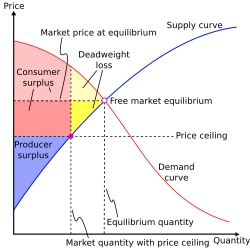
Back خسارة فادحة Arabic Pèrdua irrecuperable d'eficiència Catalan Náklady mrtvé váhy Czech Ökonomische Wohlfahrt#Wohlfahrt und Wohlfahrtsverlust German Pérdida irrecuperable de eficiencia Spanish رفاه ازدسترفته Persian Hyvinvointitappio Finnish Perte sèche French मृतभार घाटा Hindi Mrtvi teret oporezivanja Croatian
This article needs additional citations for verification. (May 2024) |
In economics, deadweight loss is the loss of societal economic welfare due to production/consumption of a good at a quantity where marginal benefit (to society) does not equal marginal cost (to society) – in other words, there are either goods being produced despite the cost of doing so being larger than the benefit, or additional goods are not being produced despite the fact that the benefits of their production would be larger than the costs. The deadweight loss is the net benefit that is missed out on. While losses to one entity often lead to gains for another, deadweight loss represents the loss that is not regained by anyone else. This loss is therefore[1] attributed to both producers and consumers.

Deadweight loss can also be a measure of lost economic efficiency when the socially optimal quantity of a good or a service is not produced. Non-optimal production can be caused by monopoly pricing in the case of artificial scarcity, a positive or negative externality, a tax or subsidy, or a binding price ceiling or price floor such as a minimum wage.
- ^ Dickson, Vaughan; He, Jian (1997). "Optimal Concentration and Deadweight Losses in Canadian Manufacturing". Review of Industrial Organization. 12 (5/6): 719–732. doi:10.1023/A:1007714502964. S2CID 150473969.
© MMXXIII Rich X Search. We shall prevail. All rights reserved. Rich X Search